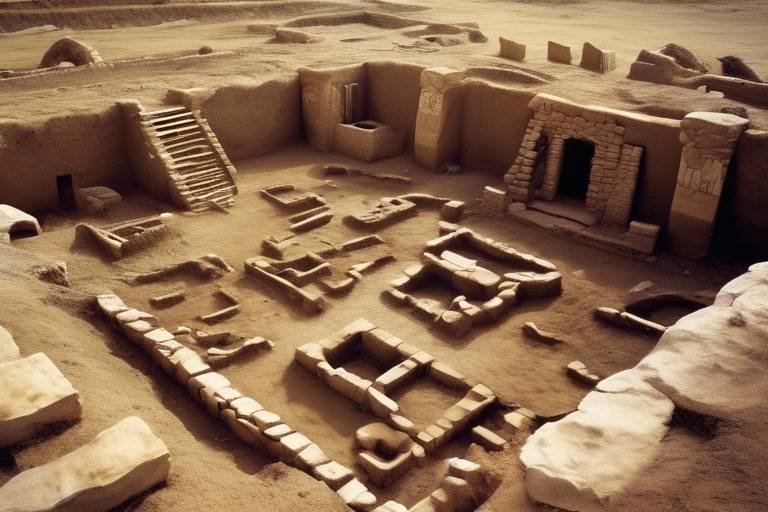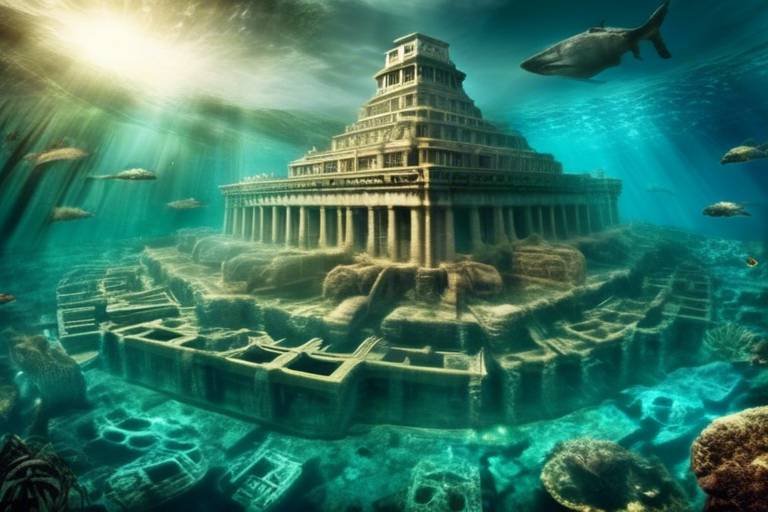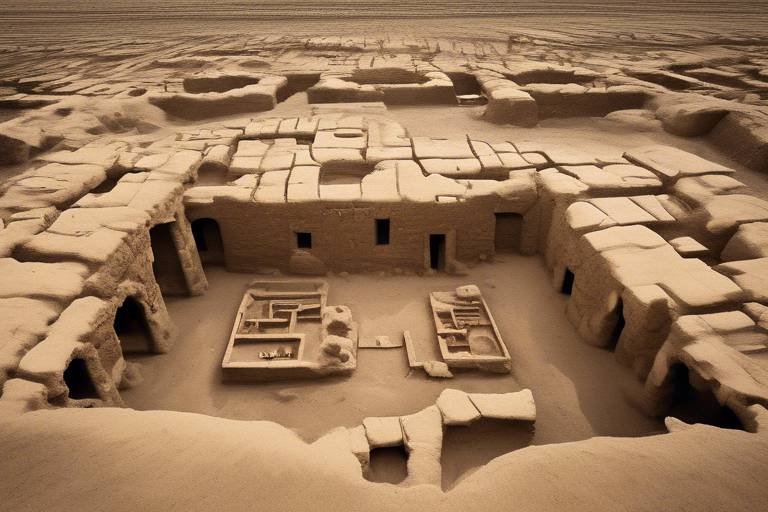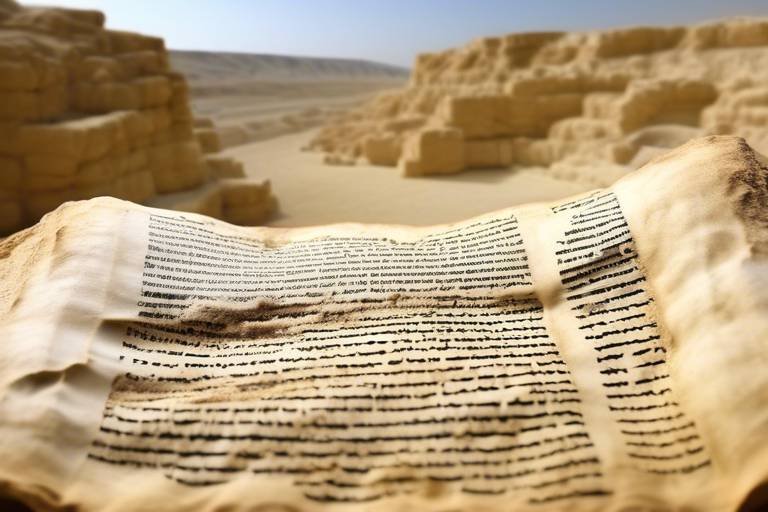The Role of Sculpture in Ancient Civilizations
Sculpture played a significant role in the artistic and cultural expressions of ancient civilizations. It served as a means of storytelling, religious worship, and political propaganda, reflecting the values and beliefs of societies from different eras.

Symbolism in Sculpture
Sculptures in ancient civilizations were not merely artistic creations but vessels of profound symbolism. These sculptures were rich with meaning, each detail carefully crafted to convey stories, beliefs, and values of the society they belonged to. Imagine a sculpture of a lion symbolizing strength and courage, or a figure of a goddess representing fertility and abundance. These symbolic representations served as visual language, allowing viewers to interpret and connect with the cultural narratives embedded in the artwork.
Furthermore, the symbolism in ancient sculptures extended beyond mere representation of deities or mythological figures. The intricate designs and motifs found in sculptures often carried hidden meanings, known only to the initiated few. For example, a serpent coiled around a figure might signify protection or wisdom in one civilization, while representing deceit or danger in another. Such layers of symbolism added depth and complexity to the sculptures, inviting viewers to delve deeper into the cultural context and significance of the artwork.
Moreover, the choice of materials and techniques in sculpting also played a crucial role in enhancing the symbolism of the artwork. The use of specific materials like marble, known for its purity and durability, or bronze, symbolizing strength and longevity, added layers of meaning to the sculptures. Techniques such as intricate carving, delicate detailing, and precise proportions further accentuated the symbolic significance of the sculptures, making them not just objects of beauty but repositories of cultural wisdom and heritage.

Materials and Techniques
Sculpture played a significant role in the artistic and cultural expressions of ancient civilizations. It served as a means of storytelling, religious worship, and political propaganda, reflecting the values and beliefs of societies from different eras.
In the realm of ancient civilizations, the choice of materials and techniques in sculpting was a crucial aspect that influenced the outcome of the artworks. Various civilizations utilized materials such as marble, bronze, and clay, each with its distinct properties and characteristics.
Marble, with its smooth texture and ability to capture intricate details, was favored by civilizations like the Greeks for creating lifelike sculptures. The durability of marble ensured that these artworks stood the test of time, preserving their beauty for centuries to come.
Bronze, known for its strength and malleability, was another popular choice among ancient sculptors. The casting process allowed for the creation of dynamic poses and intricate designs, showcasing the artistic prowess of civilizations like the Romans.
Clay, a more pliable material, was often used for creating smaller figurines and pottery in civilizations such as the Mesopotamians. Its versatility in molding and shaping made it ideal for crafting everyday objects and religious artifacts with intricate details.
The techniques employed by ancient sculptors varied from carving and modeling to casting and firing. Each technique required skill and precision, with craftsmen honing their abilities to bring their artistic visions to life.
Furthermore, the combination of materials and techniques in sculpting allowed for a diverse range of artistic expressions, from monumental statues to delicate figurines, showcasing the creativity and innovation of ancient civilizations.
1. How did ancient civilizations choose the materials for their sculptures?
Ancient civilizations selected materials based on availability, durability, and the desired aesthetic qualities. Marble, bronze, and clay were among the most commonly used materials due to their unique properties.
2. What techniques were used in ancient sculpting?
Ancient sculptors employed techniques such as carving, modeling, casting, and firing to create their artworks. These techniques required precision and skill to achieve the desired results.
3. What role did sculpture play in religious practices?
Sculptures held immense religious significance in ancient civilizations, serving as representations of deities and religious narratives in temples and shrines. They were believed to embody divine presence and were objects of worship and reverence.
4. How have ancient sculptures influenced contemporary art?
The legacy of ancient sculpture continues to inspire contemporary artists worldwide, with their innovative techniques and artistic expressions serving as a foundation for modern artistic endeavors.

Religious Significance
In ancient civilizations, sculptures held profound religious significance, serving as conduits between the mortal world and the divine realm. These intricate artworks were not merely decorative pieces but embodiments of spiritual beliefs and practices. Crafted with meticulous detail and devotion, sculptures were revered as sacred objects, believed to house the essence of deities and supernatural beings.
Ancient temples and shrines were adorned with sculptures depicting gods, goddesses, and mythical figures, inviting worshippers to connect with the divine through visual representation. The act of sculpting itself was considered a sacred ritual, with sculptors often seen as conduits channeling divine inspiration into tangible forms.
Furthermore, sculptures played a crucial role in religious ceremonies and rituals, symbolizing the presence of the divine and facilitating communication with the spiritual realm. Whether carved from marble, cast in bronze, or molded in clay, each sculpture carried symbolic meanings and religious narratives that guided the faithful in their worship and devotion.
Moreover, sculptures were not just passive objects of veneration but active participants in religious practices. They were adorned with offerings, garlands, and precious ornaments as tokens of reverence and devotion. Through these rituals, worshippers expressed their faith and sought blessings, believing in the transformative power of these sacred artworks.
Overall, the religious significance of sculptures in ancient civilizations transcended mere artistic expression, playing a vital role in shaping spiritual beliefs, rituals, and communal identity. These sacred artworks served as bridges between the earthly and divine realms, embodying the essence of faith and devotion in tangible form.

Historical Evolution
Throughout the history of ancient civilizations, the art of sculpture underwent a remarkable evolution, reflecting the changing artistic trends, societal values, and technological advancements of each era. The earliest forms of sculpture were simple figurines and fertility idols crafted by ancient peoples, symbolizing their connection to the natural world and spiritual beliefs.
As civilizations developed and expanded, so did the complexity and grandeur of sculptural works. The ancient Egyptians, known for their monumental statues and intricate tomb reliefs, utilized sculpture to immortalize pharaohs, gods, and scenes from daily life. These sculptures not only served as artistic expressions but also as tools for preserving historical events and cultural traditions.
In ancient Greece, sculpture reached new heights of realism and idealism, with artists like Phidias and Praxiteles creating iconic statues of gods, athletes, and mythological figures. The Greeks valued harmony, balance, and proportion in their sculptural works, reflecting their philosophical and aesthetic principles.
Similarly, the Romans adopted and adapted Greek sculptural techniques, using sculpture as a means of propaganda and commemoration. Emperors commissioned statues and monuments to glorify their reigns and assert their power, shaping public perception and reinforcing imperial authority.
As the medieval period dawned, sculptural art took on a more religious tone, with intricate carvings adorning cathedrals and churches across Europe. Sculptors depicted biblical scenes, saints, and religious symbols, aiming to inspire devotion and piety among the faithful.
The Renaissance marked a revival of classical ideals and artistic innovation, with sculptors like Michelangelo and Donatello producing masterpieces that showcased human anatomy and emotion in unprecedented detail. The period saw a renewed interest in ancient Greek and Roman sculpture, leading to a renaissance of sculptural techniques and styles.
By the modern era, sculpture had evolved into a diverse and dynamic art form, encompassing a wide range of styles, materials, and approaches. From traditional marble statues to avant-garde installations, sculptors continue to push the boundaries of artistic expression, exploring new concepts and challenging established norms.

Role in Commemoration
Sculptures played a vital role in ancient civilizations by serving as powerful tools for commemoration. These monumental works were often commissioned to honor significant events, rulers, and heroes, ensuring their legacy would endure through the ages. Imagine walking through a bustling city square and encountering a towering statue depicting a legendary leader, immortalized in stone for all to see. These sculptures were not merely decorative pieces but served as public memorials, symbolizing the achievements and virtues of those being commemorated.

Artistic Innovation
Artistic innovation in ancient civilizations was a driving force behind the evolution of sculptural art. Sculptors of the past were not content with mere replication; they sought to push the boundaries of creativity and craftsmanship, exploring new styles, poses, and expressions in their works. These pioneers of art experimented with different techniques and materials, giving rise to unique and groundbreaking sculptures that captivated the imagination of their audiences.
One notable aspect of artistic innovation in ancient sculpture was the depiction of movement and emotion. Sculptors skillfully captured dynamic poses and intricate facial expressions, infusing their works with a sense of life and vitality. Through their art, they were able to convey complex emotions and narratives, engaging viewers on a profound level and transcending mere physical representation.
Furthermore, artistic innovation in sculpture extended to the exploration of different themes and subjects. Ancient sculptors delved into a wide range of topics, from mythological tales to everyday life, expanding the scope of sculptural art and enriching the cultural landscape of their civilizations. By experimenting with diverse subject matters, they were able to create a diverse body of work that reflected the multifaceted nature of human experience.
Moreover, the use of innovative techniques and tools in sculpting contributed to the advancement of the art form. Ancient sculptors developed new methods for carving, modeling, and casting, allowing them to achieve unprecedented levels of detail and intricacy in their creations. These technical advancements not only enhanced the aesthetic appeal of sculptures but also paved the way for future generations of artists to explore new possibilities in the medium.
In conclusion, artistic innovation played a vital role in shaping the trajectory of sculptural art in ancient civilizations. The creative vision and experimental spirit of ancient sculptors laid the foundation for the diverse and dynamic art forms that continue to inspire and captivate audiences to this day.

Political Propaganda
Sculptures in ancient civilizations were not merely artistic expressions but powerful tools of . Rulers and leaders utilized sculptures to portray themselves in a favorable light, emphasizing their power and authority. These monumental statues and reliefs served as visual symbols of legitimacy, shaping public perception and ideology. Through intricate designs and imposing sizes, sculptures were strategically placed in public spaces to assert dominance and control over the masses.

Legacy and Influence
The legacy of ancient sculpture is profound, shaping the course of art and culture throughout history. These masterpieces serve as a timeless testament to the creativity and skill of ancient sculptors, inspiring awe and admiration in viewers across the globe. The influence of ancient sculptures can be seen in various art forms, from architecture to modern sculpture, as artists draw inspiration from the techniques and themes of their predecessors.
Ancient sculptures continue to captivate audiences with their beauty and craftsmanship, standing as enduring symbols of human creativity and ingenuity. The intricate details and symbolic meanings embedded in these works offer a glimpse into the beliefs and values of past civilizations, enriching our understanding of the cultural tapestry of humanity.
Moreover, the legacy of ancient sculpture extends beyond the realm of art, influencing philosophical thought, religious practices, and historical interpretations. These sculptures not only serve as aesthetic marvels but also as historical artifacts that provide valuable insights into the lives and beliefs of ancient peoples.
As contemporary artists seek to push the boundaries of artistic expression, they often look to the past for inspiration, drawing upon the rich heritage of ancient sculpture to create innovative and thought-provoking works. The enduring legacy of ancient sculpture reminds us of the power of art to transcend time and connect us to our shared human experience.
Frequently Asked Questions
- What role did sculpture play in ancient civilizations?
Sculpture played a significant role in the artistic and cultural expressions of ancient civilizations. It served as a means of storytelling, religious worship, and political propaganda, reflecting the values and beliefs of societies from different eras.
- How were sculptures in ancient civilizations symbolic?
Sculptures in ancient civilizations were laden with symbolism, representing various gods, heroes, and mythological creatures. The intricate designs and details conveyed cultural narratives and beliefs, providing insight into the society's values.
- What materials and techniques were used in ancient sculpture?
Different ancient civilizations utilized various materials and techniques in sculpting, such as marble, bronze, and clay. Each material and technique had its unique properties, influencing the style and durability of the sculptures created.
- Why were sculptures significant in religious contexts?
Sculptures held immense religious significance in ancient civilizations, often used in temples and shrines to depict deities and religious narratives. They were believed to embody divine presence and serve as objects of worship and reverence.
- How did sculptures evolve over time in ancient civilizations?
The art of sculpture evolved over time in ancient civilizations, reflecting changes in artistic styles, techniques, and societal norms. From simple figurines to grand statues, sculptures mirrored the cultural progression and historical events of their time.
- What was the role of sculptures in political contexts?
Sculptures were often employed as tools of political propaganda in ancient civilizations, portraying rulers and leaders in a favorable light. These monumental statues and reliefs conveyed power, authority, and legitimacy, shaping public perception and ideology.
- How has ancient sculpture influenced contemporary art?
The legacy of ancient sculpture continues to influence contemporary art and culture, inspiring artists and scholars worldwide. The enduring beauty and significance of these ancient artworks serve as a testament to the enduring impact of sculpture in shaping human history.


















